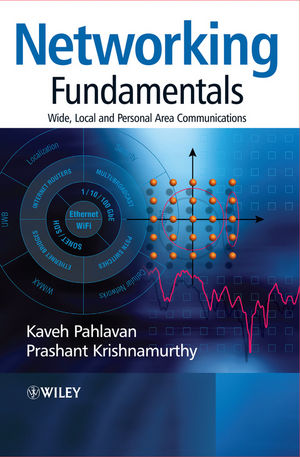|
Textbook
Networking Fundamentals: Wide, Local and Personal Area CommunicationsISBN: 978-0-470-99290-6
Paperback
656 pages
June 2009, ©2009
 Other Available Formats: Hardcover
|
||||||
Preface.
1. Introduction to Information Networks.
1.1 Introduction.
1.2 Evolution of Wide-Area Networks.
1.3 Evolution of Local Networks.
1.4 Structure of the book.
PART ONE: FUNDAMENTALS OF TRANSMISSION AND ACCESS.
2. Characteristics of the Medium.
2.1 Introduction.
2.2 Guided Media.
2.3 Wireless Media.
3. Fundamentals of Physical Layer Transmission.
3.1 Information Transmission.
3.2 Transmission Techniques and Signal Constellation.
3.3 Performance of the Physical Layer.
3.4 Wideband Modems.
4. Coding and Reliable Packet Transmission.
4.1 Introduction.
4.2 Source Coding and Framing Techniques.
4.3 FEC Coding.
4.4 Coding for Spread-Spectrum and Code-Division Multiple Access Systems.
4.5 ARQ Schemes.
4.6 Flow Control Protocols.
5. Medium Access Methods.
5.1 Introduction.
5.2 Centralized Assigned Access Schemes.
5.3 Distributed Random Access Networks.
5.4 Integration of Voice and Data Traffic.
PART TWO: WIDE-AREA NETWORKS.
6. The Internet.
6.1 Introduction: Internet Infrastructure.
6.2 Addressing.
6.3 Quality of Service.
6.4 Bridges or LAN Switches.
6.5 Switches.
6.6 Routers.
7. Cellular Networks.
7.1 Introduction.
7.2 General Architecture of a Cellular Network.
7.3 Mechanisms to Support a Mobile Environment.
7.4 Protocol Stack in Cellular Networks.
7.5 Physical Layer in TDMA Air Interface.
7.6 Physical Layer in CDMA Air Interface.
7.7 Achieving Higher Data Rates in Cellular Networks.
7.8 Deployment of Cellular Networks.
PART THREE: LOCAL AND PERSONAL-AREA NETWORKS.
8. IEEE 802-3 Ethernet.
8.1 Introduction.
8.2 Legacy 10 Mb/s Ethernet.
8.3 Evolution of the Physical Layer.
8.4 Emergence of Additional Features for Ethernet.
9. IEEE Wireless Local-Area Network Standards.
9.1 Introduction.
9.2 IEEE 802.11 and WLANs.
9.3 IEEE 802.16 (WiMAX).
10. IEEE 802.15 Wireless Personal-Area Network.
10.1 Introduction.
10.2 IEEE 802.15.1 Bluetooth.
10.3 Interference between Bluetooth and 802.11.
10.4 IEEE 802.15.3 Ultra Wideband Wireless.
10.5 IEEE 802.15.4 ZigBee.
PART FOUR: SYSTEM ASPECTS.
11. Network Security.
11.1 Introduction.
11.2 Network Attacks and Security Issues.
11.3 Protection and Prevention.
11.4 Detection.
11.5 Assessment and Response.
12. Wireless Localization.
12.1 Introduction.
12.2 What is Wireless Geolocation?
12.3 RF Location Sensing and Positioning Methodologies.
12.4 LCS Architecture for Cellular Systems.
12.5 Positioning in Ad Hoc and Sensor Networks.
13. Wireless Sensor Networks.
13.1 Introduction.
13.2 Sensor Network Applications.
13.3 Sensor Network Architecture and Sensor Devices.
13.4 The PHY Layer in Sensor Networks.
13.5 The MAC Layer in Sensor Networks.
13.6 Higher Layer Issues in Sensor Networks.
References.
Appendix A: What is Decibel?
Appendix B: STC for Two Transmitters and One Receiver.
Appendix C: Source Coding.
C.1 Source Coding for Voice.
C.2 Source Coding for Images and Video.
Appendix D: Acronyms.
Appendic E: List of Variables.
Index.



